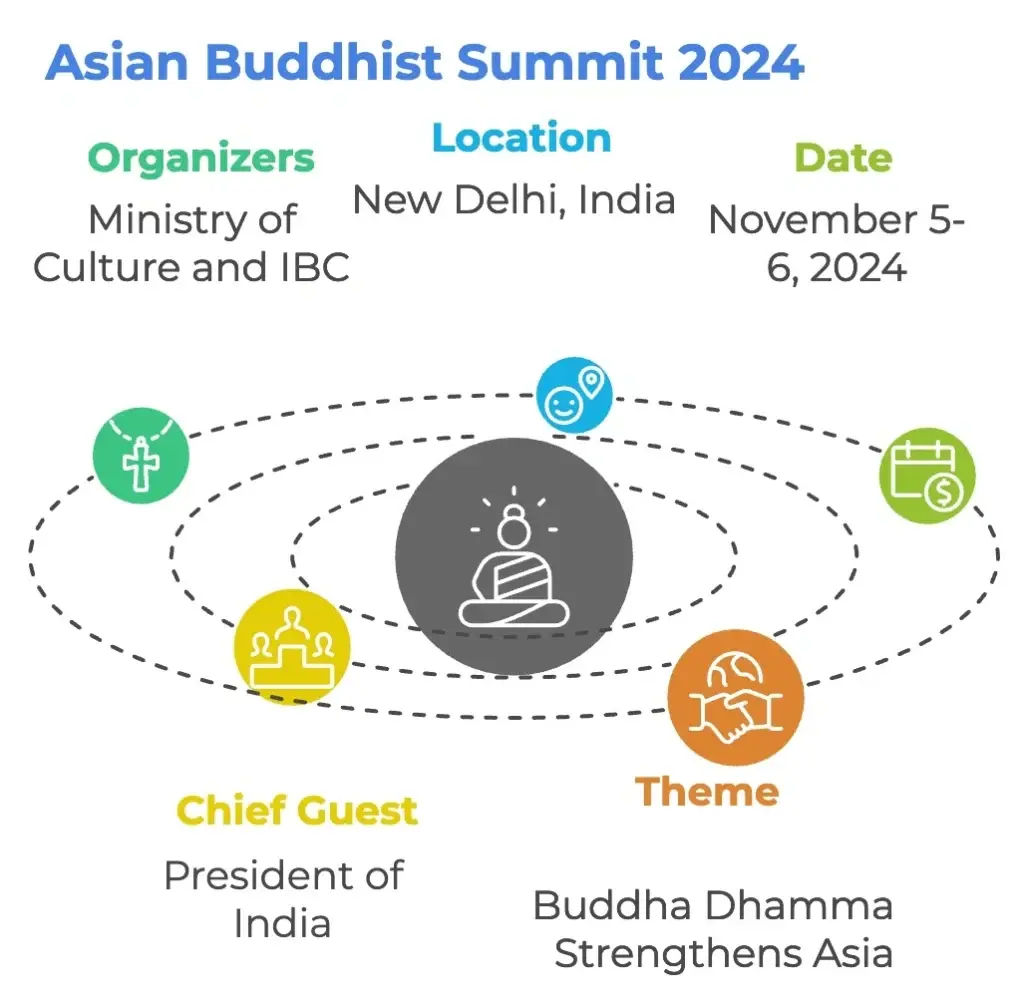Poverty
Outline
- The Human Development Report (1997) of the United Nations Development Programme (UNDP) explains that poverty is not just about a lack of money but also about missing choices and opportunities that allow a person to live a life of dignity.
- This definition takes into consideration whether people have access to basic services and their ability to contribute entirely to society.
- Poverty is defined as not having enough resources to meet basic needs like food, shelter, and clothing as well as lack of access to healthcare and education which leads to a low quality of life.
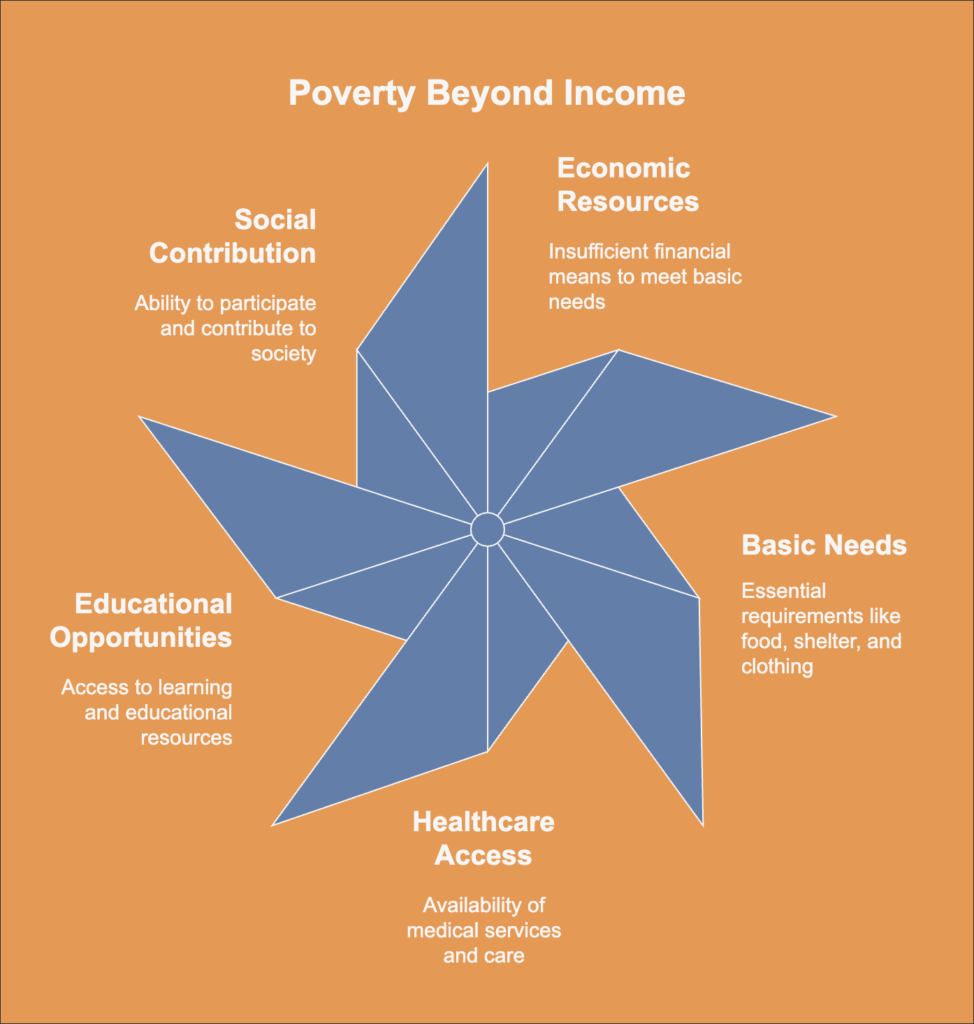
Types of Poverty
Poverty can be divided into two main types:
- Absolute Poverty: This shows having a low income that is unable to meet necessities like food, clothing, and shelter. It is widely used to measure extreme poverty and show how people struggle to survive.
- Relative Poverty: This happens when a person has less money compared to others in their community or country. They might meet basic needs but cannot maintain the standard of living enjoyed by most people around them.
Other Terms Related to Poverty
- Chronic Poor: These people remain poor for a long time. They lack the resources or opportunities needed to improve their situation.
- Churning Poor: These people generally move into and out of poverty. For example, small farmers or seasonal workers may earn during peak seasons but struggle at other times.
- Occasionally Poor: These people are commonly wealthy but they face short-term problems due to unusual events which make them poor for a short period.
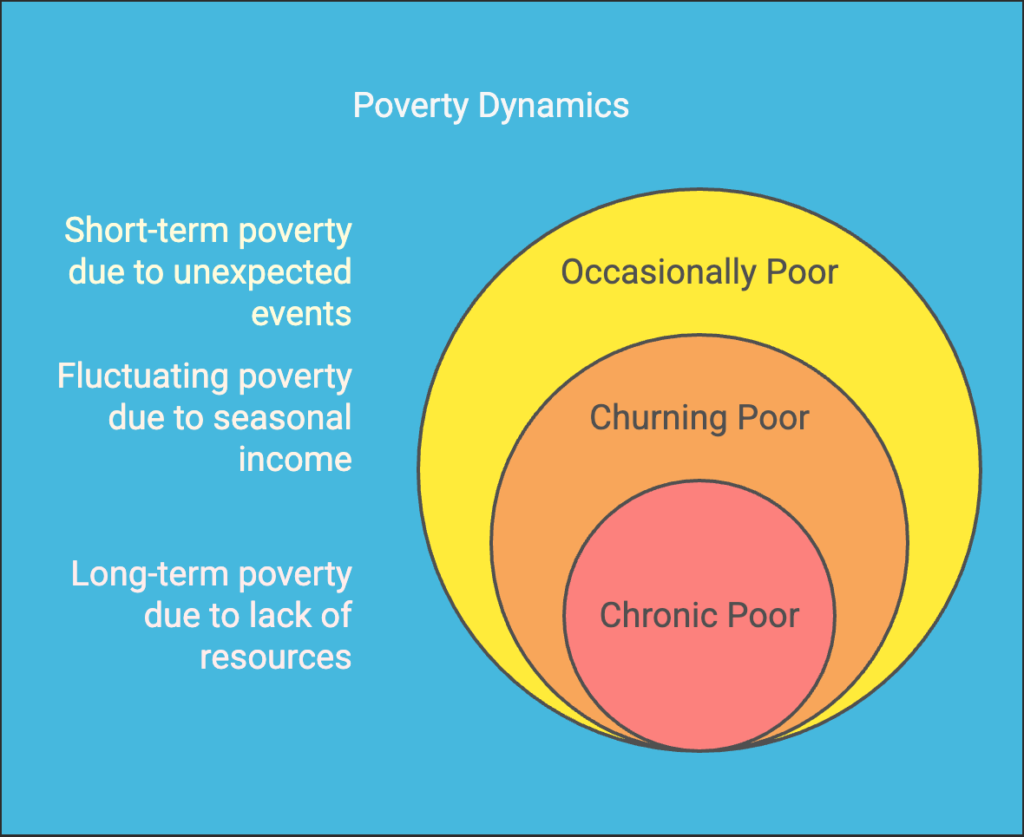
Measurement of Poverty in India
- The poverty line is a threshold set to determine if a person is poor or not.
- A person is considered Below the Poverty Line (BPL) if their income is below this threshold.
- Those with income above the poverty line are classified as Above the Poverty Line (APL).
Important Committee
Before Independence (1938):
- National Planning Committee first discussed poverty in India.
- The focus was on defining minimum needs like food and housing.
After Independence:
- In 1962, a Working Group established separate poverty lines for rural and urban areas:
- Rural areas: Income less than Rs .20 per month.
- Urban areas: Income less than Rs . 25 per month.
Y.K. Alagh Committee (1979):
- Defined the poverty line based on calorie intake:
- Rural areas: 2400 calories per person per day.
- Urban areas: 2100 calories per person per day.
Lakdawala Expert Group (1993):
- Focused on minimum consumption needs.
- Adjusted for price differences in rural and urban areas.
Tendulkar Committee (2009):
- Revised the method and considered monthly income:
- Rural areas: 816 rupees per person per month.
- Urban areas: 1000 rupees per person per month.
Rangarajan Committee (2014):
- Further revised poverty measurement:
- Rural areas: 32 rupees per person per day.
- Urban areas: 47 rupees per person per day.
Current Method
- Poverty is determined by the income level and calorie intake.
- If a person’s income is below the set threshold and they cannot meet the required calorie intake, they are classified as BPL.
| Area | Calorie Requirement | Income Threshold |
| Rural | 2400 calories/day | 816 rupees/month |
| Urban | 2100 calories/day | 1000 rupees/month |
Headcount Ratio
- The Headcount Ratio (HCR) is the percentage of the population that lives below the Poverty Line (BPL). It helps in assessing the extent of poverty in a country.
- Headcount Ratio (HCR)=(Number of BPL Population/Total Population)×100
- The headcount ratio in India was 21.9% as of 2011. This means that 21.9% of India’s population lived below the poverty line at that time.
- The World Bank defined the international poverty line as $2.15 per day based on Purchasing Power Parity (PPP) in 2017.
- The poverty rate in India was 12.92% in 2021 according to the World Bank’s Poverty and Equity Report 2022.
Global Multidimensional Poverty Index (MPI):
- The Global MPI is a tool that helps to measure poverty by looking at multiple factors. It was developed by the Oxford Poverty and Human Development Initiative (OPHI) and the United Nations Development Programme (UNDP).
- The MPI considers various dimensions of poverty to show how people live in different parts of the world.
- 584 million people globally are classified as multidimensionally poor based on this index.
- The Global MPI is used to track progress in the eradication of poverty, particularly on the International Day for the Eradication of Poverty which has been observed since 1992.
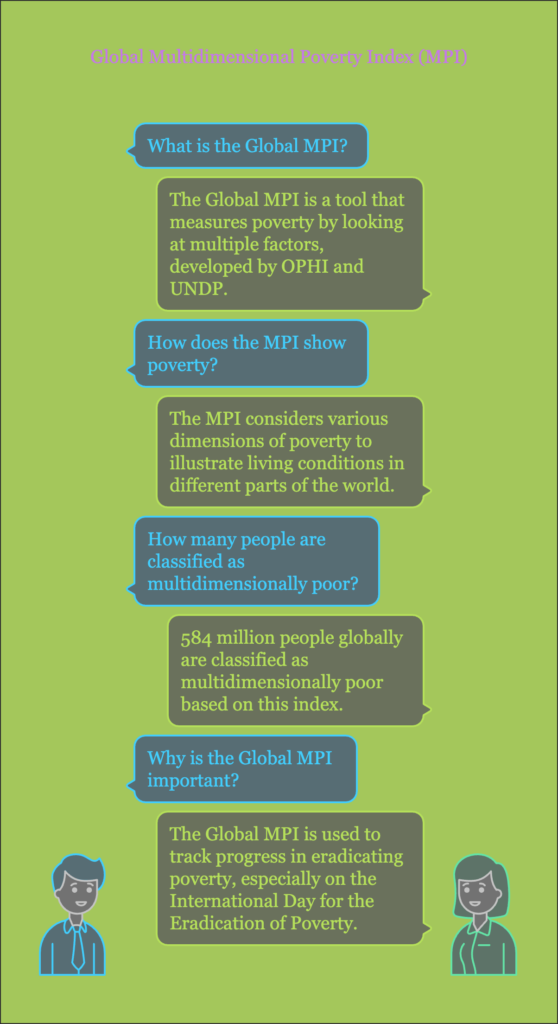
Dimensions of Poverty in MPI
The MPI evaluates poverty through three main dimensions:
- Health
- Education
- Living Standards
Each dimension has specific indicators that help to measure different aspects of poverty.
1. Health
- Nutrition: Measures if individuals have enough food to stay healthy.
- Child Mortality: Look at the number of children who die before reaching five years old.
2. Education
- Years of Schooling: Counts the number of years a person has attended school.
- School Attendance: Checks if children are attending school regularly.
3. Living Standards
- Cooking Fuel: Determines the type of fuel used for cooking (clean or polluting).
- Sanitation: Assesses access to clean and safe toilet facilities.
- Drinking Water: Evaluate access to safe drinking water.
- Electricity: Checks if households have electricity.
- Housing: Looks at the quality of housing, including materials used for walls and roofs.
- Assets: Measures ownership of assets like a refrigerator, television, or bicycle.
How is MPI Calculated?
- The MPI uses specific weights for each indicator to calculate the overall poverty level. Here is how the weights are distributed:
| Dimension | Indicator | Weight |
| Health | Nutrition | 1/6 |
| Child Mortality | 1/6 | |
| Education | Years of Schooling | 1/6 |
| School Attendance | 1/6 | |
| Living Standards | Cooking Fuel | 1/12 |
| Sanitation | 1/12 | |
| Drinking Water | 1/12 | |
| Electricity | 1/12 | |
| Housing | 1/12 | |
| Assets | 1/12 |
National Multidimensional Poverty Index (NMPI)
- The National Multidimensional Poverty Index (NMPI) was developed by NITI Aayog and uses similar dimensions.
- Its goal is to more precisely measure poverty at the national level, directing initiatives like the Jan Dhan Yojana, which attempts to grow financial inclusion.
Causes of Poverty in India:
Poverty in India comes from several factors. These factors can be divided into four main categories: historical, social, economic, and political.
- Historical Factors
- British Rule took wealth from India. The British rulers extracted resources and money for their gain.
- Destruction of Local Industries occurred when British goods replaced Indian products. This action led to job loss for many workers and artisans.
- Social Factors
- High Illiteracy keeps many people unable to read or write, which limits their ability to get better jobs.
- Poor Family Planning results in a large population and makes it hard for families to get enough resources for basic needs.
- Economic Factors
- Lack of Capital and Skills stops people from starting businesses or learning new skills that can improve their income.
- The cycle of Poverty locks people in low income because they have no savings, cannot invest, and cannot improve their situation.
- Political Factors
- Policy Failures refer to government plans that did not succeed. Corruption and poor execution caused unequal access to resources.
| Important Policies and Programmes Aimed at Poverty Alleviation | ||
| Scheme | Year | Objective |
| Integrated Rural Development Programme (IRDP) | 1978-79 | Aims to uplift the rural poor by providing loans and subsidies. |
| Revamped Public Distribution System (RPDS) | 1992 | Improves food security by offering essential commodities at subsidized rates in rural and urban areas. |
| Targeted Public Distribution System (TPDS) | 1997 | Focuses on targeting food subsidies to the most vulnerable sections of the population, ensuring food security. |
| NITI Aayog Task Force on Poverty Alleviation | 2015 | Develops strategies for reducing poverty through reforms and improved policy implementation. |
| Mahatma Gandhi National Rural Employment Guarantee Act (MGNREGA) | 2005 | Guarantees 100 days of wage employment annually to rural households, enhancing livelihood security. |
| National Rural Livelihoods Mission (NRLM) | 2011 | Promotes self-employment through self-help groups (SHGs), aiming to reduce rural poverty. |
| Pradhan Mantri Jan Dhan Yojana (PMJDY) | 2014 | Focuses on financial inclusion by opening bank accounts for the unbanked and facilitating direct benefit transfers. |
Sustainable Development Goal (SDG)
- The SDGs were established in 2015 as a successor to the Millennium Development Goals (MDGs) which focused on reducing global poverty and improving social conditions from 2000 to 2015.
- All 193 United Nations member states adopted the SDGs as part of the 2030 Agenda for Sustainable Development during the UN General Assembly in September 2015,
- The SDGs consist of 17 goals and 169 targets with the goal of achieving sustainable development in social, economic, and environmental dimensions by 2030
| Sustainable Development Goal (SDG) | Goal Number | Focus | Key Action |
| No Poverty | 1 | End poverty in all its forms everywhere. | Over 700 million people live in extreme poverty. |
| Zero Hunger | 2 | End hunger, achieve food security, improve nutrition, and promote sustainable agriculture. | 821 million people are undernourished while a third of food is wasted. |
| Good Health and Well-Being | 3 | Ensure healthy lives and promote well-being for all ages. | Vaccinations led to an 80% reduction in measles deaths between 2000 and 2017. |
| Quality Education | 4 | Ensure inclusive and equitable quality education for all. | 617 million children lack basic proficiency in reading and mathematics. |
| Gender Equality | 5 | Achieve gender equality and empower women and girls. | 1 in 3 women experiences physical or sexual violence. |
| Clean Water and Sanitation | 6 | Ensure availability and sustainable management of water and sanitation for all. | More than 40% of the world’s population faces water scarcity. |
| Affordable and Clean Energy | 7 | Ensure access to affordable, reliable, sustainable, and modern energy for all. | 3 billion people lack access to clean cooking fuels. |
| Decent Work and Economic Growth | 8 | Promote sustainable economic growth and decent work for all. | 1 in 5 young people is not in education, employment, or training. |
| Industry, Innovation, and Infrastructure | 9 | Build resilient infrastructure and promote inclusive industrialization. | Many developing countries lack basic infrastructure like roads and electricity. |
| Reduced Inequalities | 10 | Reduce inequality within and among countries. | The poorest 40% earn less than 25% of global income. |
| Sustainable Cities and Communities | 11 | Make cities inclusive, safe, resilient, and sustainable. | 9 out of 10 urban residents breathe polluted air. |
| Responsible Consumption and Production | 12 | Ensure sustainable consumption and production patterns. | By 2050, three times the Earth’s resources could be required to sustain current lifestyles. |
| Climate Action | 13 | Take urgent action to combat climate change and its impacts. | Global CO2 emissions have increased by almost 50% since 1990. |
| Life Below Water | 14 | Conserve and sustainably use oceans, seas, and marine resources. | Over 3 billion people depend on marine biodiversity for their livelihoods. |
| Life on Land | 15 | Protect, restore, and promote sustainable use of terrestrial ecosystems. | Forests house over 80% of terrestrial species. |
| Peace, Justice, and Strong Institutions | 16 | Promote peaceful and inclusive societies and provide access to justice. | Over 70.8 million people were displaced due to war and conflict in 2018. |
| Partnerships for the Goals | 17 | Strengthen global partnerships to support sustainable development. | Achieving the SDGs could unlock $12 trillion in market opportunities by 2030. |
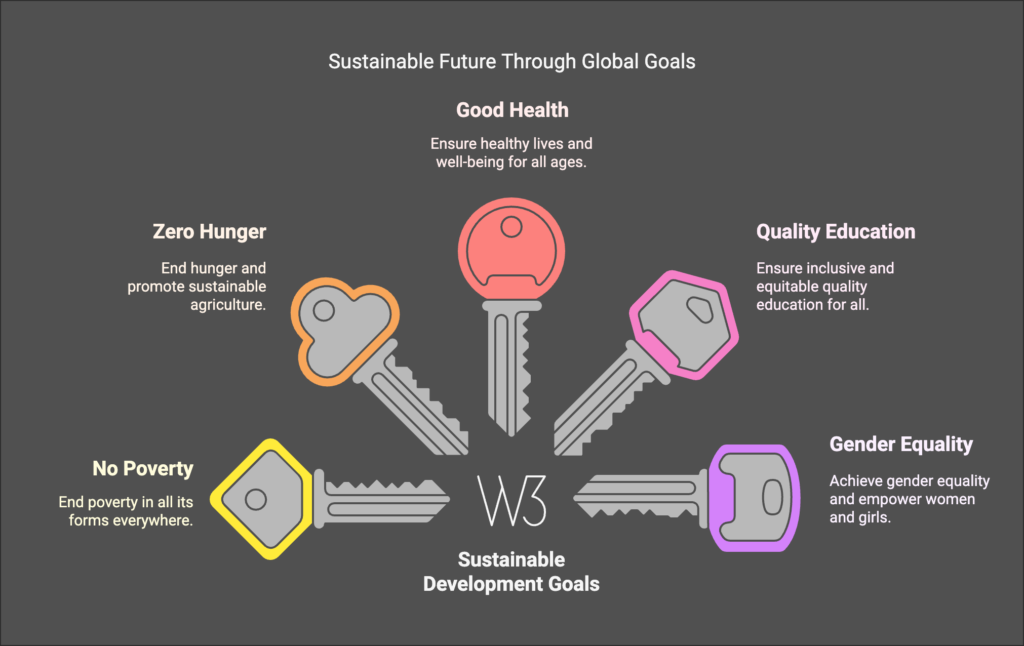
Most Viewed Posts
- Special Campaign 4.0 for Swachhata and Minimizing Pendency: Key Achievements and Strategies
- Indian Army Recruitment 2024 notification is out
- India Showcases Remarkable Progress in Poverty Eradication, Employment, and Social Protection at the 352nd ILO Governing Body Meeting
- MPHC Junior Judicial Assistant (JJA) Recruitment 2024
- Measurement and Physical Quantities

